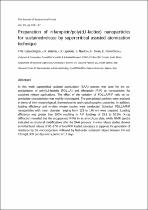 ResearchSpace
ResearchSpace
Preparation of rifampicin/poly(d,l-lactice) nanoparticles for sustained release by supercritical assisted atomization technique
JavaScript is disabled for your browser. Some features of this site may not work without it.
- ResearchSpace
- →
- Research Publications/Outputs
- →
- Journal Articles
- →
- View Item
| dc.contributor.author |
Labuschagne, Philip W

|
|
| dc.contributor.author |
Adami, R

|
|
| dc.contributor.author |
Liparoti, S

|
|
| dc.contributor.author |
Naidoo, Saloshnee

|
|
| dc.contributor.author |
Swai, H

|
|
| dc.contributor.author |
Reverchon, E

|
|
| dc.date.accessioned | 2015-02-09T07:28:38Z | |
| dc.date.available | 2015-02-09T07:28:38Z | |
| dc.date.issued | 2014-11 | |
| dc.identifier.citation | Labuschagne, P.W., Adami, R., Liparoti, S., Naidoo, S., Swai, H and Reverchon, E. 2014. Preparation of rifampicin/poly(d,l-lactice) nanoparticles for sustained release by supercritical assisted atomization technique. The Journal of Supercritical Fluids, vol. 95, pp 106-117 | en_US |
| dc.identifier.issn | 0896-8446 | |
| dc.identifier.uri | http://ac.els-cdn.com/S089684461400237X/1-s2.0-S089684461400237X-main.pdf?_tid=dab50b8a-a6c5-11e4-9554-00000aacb35e&acdnat=1422433123_f45379cb9492ccc878c2c75cd17c64c0 | |
| dc.identifier.uri | http://hdl.handle.net/10204/7861 | |
| dc.description | Copyright: 2014 Elsevier. Only the abstract if provided. The fulltext version of the work is published in The Journal of Supercritical Fluids, vol. 95, pp 106-117 and is available from the publisher. | en_US |
| dc.description.abstract | In this work supercritical assisted atomization (SAA) process was used for the co-precipitation of poly(d,l-lactide) (PDLLA) and rifampicin (RIF) as nanoparticles for sustained release applications. The effect of the variation of PDLLA/RIF ratio on co-precipitate characteristics was mainly investigated. The precipitated particles were analyzed in terms of their morphological, thermodynamic and crystallographic properties. In addition, loading efficiency and in-vitro release studies were conducted. Spherical PDLLA/RIF nanoparticles with mean diameter ranging from 123 to 148 nm were prepared. Loading efficiency was greater than 100% resulting in RIF loadings of 28.8 to 50.5%. X-ray diffraction revealed that the encapsulated RIFis in an amorphous state, while NMR spectra indicated no structural modifications after the SAA pro-cess. In-vitro release studies showed an initial burst release of 80–87% of total RIF loaded, necessary to suppress the generation of resistance by the microorganism, followed by first-order sustained release between 0.4 and 0.8 mg/L RIF per day over a period of 17 days. | en_US |
| dc.language.iso | en | en_US |
| dc.publisher | Elsevier | en_US |
| dc.relation.ispartofseries | Workflow;14141 | |
| dc.subject | Rifampicin | en_US |
| dc.subject | Poly(d,l-lactide) | en_US |
| dc.subject | Supercritical assisted atomization | en_US |
| dc.subject | SAA | en_US |
| dc.subject | Nano-encapsulation | en_US |
| dc.title | Preparation of rifampicin/poly(d,l-lactice) nanoparticles for sustained release by supercritical assisted atomization technique | en_US |
| dc.type | Article | en_US |
| dc.identifier.apacitation | Labuschagne, P. W., Adami, R., Liparoti, S., Naidoo, S., Swai, H., & Reverchon, E. (2014). Preparation of rifampicin/poly(d,l-lactice) nanoparticles for sustained release by supercritical assisted atomization technique. http://hdl.handle.net/10204/7861 | en_ZA |
| dc.identifier.chicagocitation | Labuschagne, Philip W, R Adami, S Liparoti, Saloshnee Naidoo, H Swai, and E Reverchon "Preparation of rifampicin/poly(d,l-lactice) nanoparticles for sustained release by supercritical assisted atomization technique." (2014) http://hdl.handle.net/10204/7861 | en_ZA |
| dc.identifier.vancouvercitation | Labuschagne PW, Adami R, Liparoti S, Naidoo S, Swai H, Reverchon E. Preparation of rifampicin/poly(d,l-lactice) nanoparticles for sustained release by supercritical assisted atomization technique. 2014; http://hdl.handle.net/10204/7861. | en_ZA |
| dc.identifier.ris | TY - Article AU - Labuschagne, Philip W AU - Adami, R AU - Liparoti, S AU - Naidoo, Saloshnee AU - Swai, H AU - Reverchon, E AB - In this work supercritical assisted atomization (SAA) process was used for the co-precipitation of poly(d,l-lactide) (PDLLA) and rifampicin (RIF) as nanoparticles for sustained release applications. The effect of the variation of PDLLA/RIF ratio on co-precipitate characteristics was mainly investigated. The precipitated particles were analyzed in terms of their morphological, thermodynamic and crystallographic properties. In addition, loading efficiency and in-vitro release studies were conducted. Spherical PDLLA/RIF nanoparticles with mean diameter ranging from 123 to 148 nm were prepared. Loading efficiency was greater than 100% resulting in RIF loadings of 28.8 to 50.5%. X-ray diffraction revealed that the encapsulated RIFis in an amorphous state, while NMR spectra indicated no structural modifications after the SAA pro-cess. In-vitro release studies showed an initial burst release of 80–87% of total RIF loaded, necessary to suppress the generation of resistance by the microorganism, followed by first-order sustained release between 0.4 and 0.8 mg/L RIF per day over a period of 17 days. DA - 2014-11 DB - ResearchSpace DP - CSIR KW - Rifampicin KW - Poly(d,l-lactide) KW - Supercritical assisted atomization KW - SAA KW - Nano-encapsulation LK - https://researchspace.csir.co.za PY - 2014 SM - 0896-8446 T1 - Preparation of rifampicin/poly(d,l-lactice) nanoparticles for sustained release by supercritical assisted atomization technique TI - Preparation of rifampicin/poly(d,l-lactice) nanoparticles for sustained release by supercritical assisted atomization technique UR - http://hdl.handle.net/10204/7861 ER - | en_ZA |





